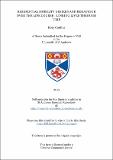Files in this item
Residential mobility desires and behaviour over the life course : linking lives through time
Item metadata
| dc.contributor.advisor | van Ham, Maarten | |
| dc.contributor.advisor | Findlay, Allan M. | |
| dc.contributor.author | Coulter, Rory | |
| dc.coverage.spatial | 267 | en_US |
| dc.date.accessioned | 2013-04-11T11:09:21Z | |
| dc.date.available | 2013-04-11T11:09:21Z | |
| dc.date.issued | 2013-06 | |
| dc.identifier.uri | https://hdl.handle.net/10023/3476 | |
| dc.description.abstract | As residential mobility recursively links individual life courses and the characteristics of places, it is unsurprising that geographers have long sought to understand how people make moving decisions. However, much of our knowledge of residential mobility processes derives from cross-sectional analyses of either mobility decision-making or moving events. Comparatively few studies have linked these separate literatures by analysing how residential (im)mobility decisions unfold over time within particular biographical, household and spatio-temporal contexts. This is problematic, as life course theories suggest that people frequently do not act in accordance with their underlying moving desires. To evaluate the extent to which residential (im)mobility is volitional or the product of constraints therefore requires a longitudinal approach linking moving desires to subsequent moving behaviour. This thesis develops this longitudinal perspective through four linked empirical studies, which each use British Household Panel Survey data to analyse how the life course context affects the expression and realisation of moving desires. The first study investigates how people make moving decisions in different ways in response to different motivations, triggers and life events. The second study harnesses the concept of ‘linked lives’, exploring the extent to which the likelihood of realising a desire to move is dependent upon the desires of a person’s partner. The third study analyses the biographical dimension of mobility decision-making, investigating how the long-term trajectories of life course careers are associated with particular mobility biographies. The final empirical chapter develops these insights, exploring the duration and abandonment of moving desires. Taken together, these studies test and extend conceptual models of mobility decision-making by empirically engaging with neglected facets of life course theories. Fundamentally, the thesis uncovers how aggregate mobility patterns are produced by the interactions between individual choices and multi-scalar constraints. | en_US |
| dc.language.iso | en | en_US |
| dc.publisher | University of St Andrews | en |
| dc.rights | Creative Commons Attribution 3.0 Unported | |
| dc.rights.uri | http://creativecommons.org/licenses/by/3.0/ | |
| dc.subject | Residential mobility | en_US |
| dc.subject | Migration | en_US |
| dc.subject | Moving desires | en_US |
| dc.subject | Life course | en_US |
| dc.subject | Longitudinal analysis | en_US |
| dc.subject.lcc | HD7288.9C7 | |
| dc.subject.lcsh | Residential mobility | en_US |
| dc.subject.lcsh | Residential mobility--Great Britain--Case studies | en_US |
| dc.subject.lcsh | Moving, Household | en_US |
| dc.subject.lcsh | Longitudinal method | en_US |
| dc.title | Residential mobility desires and behaviour over the life course : linking lives through time | en_US |
| dc.type | Thesis | en_US |
| dc.type.qualificationlevel | Doctoral | en_US |
| dc.type.qualificationname | PhD Doctor of Philosophy | en_US |
| dc.publisher.institution | The University of St Andrews | en_US |
| dc.publisher.department | Centre for Housing Research; Department of Geography and Sustainable Development | en_US |
This item appears in the following Collection(s)
Except where otherwise noted within the work, this item's licence for re-use is described as Creative Commons Attribution 3.0 Unported
Items in the St Andrews Research Repository are protected by copyright, with all rights reserved, unless otherwise indicated.


